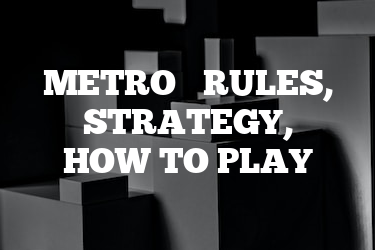Metro Tile-Based Game – A Guide to Rules, Instructions and Strategy Tips
Introduction
Metro, a tile-based board game that’s all about building metro lines in Paris at the turn of the 20th century. It’s a game where you lay down tiles to create the longest possible metro routes. The game was designed by Dirk Henn and first hit the shelves in 2000. It’s a mix of strategy and luck, and I find it’s pretty fun once you get the hang of it. P

layers score points based on the length of their metro lines and how well they connect to the central stations. It’s a game for 2 to 6 players, so you can play it with a few friends or at a family gathering. The cool thing about Metro is that it’s easy to learn but has enough depth to keep you coming back for more.
Quick Tip for Metro
Always keep an eye on your opponents’ lines. Blocking their routes can be just as important as extending your own!
Rules for playing Metro
Let’s dive into the rules of Metro. The goal is to create the longest metro lines. Each player gets a set of trains in their color. You’ll be placing tiles on the board to extend your line from the edge of the board towards the center. The game ends when all the tiles are placed. Then, you score points for each tile your train line passes through, with extra points if you reach the central stations or if your line goes through the same tile more than once.
Each turn, you pick a tile and place it on the board. The tiles have different track layouts, so you need to think about how they’ll extend your line. You can’t place a tile that would make a line run into the edge of the board or into another line without connecting properly. If you can’t place a tile, you have to discard it, which can be a real pain.
There’s also a variant where you can play with stations, which changes how you score points. It’s a bit more complex, but it adds another layer to the game. The key is to plan ahead and adapt your strategy based on the tiles you draw and what your opponents are doing.
Equipment and Setup for Metro
For Metro, you need the game board, tiles, and trains. The board is a grid with edge stations and central stations. The tiles show different track layouts, and each player has a set of trains in their color. To set up, place the board in the middle, give each player their trains, and shuffle the tiles. Each player draws one tile to start with.
There are four types of tiles: straight, curved, junction, and special. Straight and curved tiles are simple, just tracks that go straight or turn. Junction tiles have tracks that split, and special tiles might have tracks that cross over each other.
How to Play Metro and Game Mechanics
Playing Metro is about placing tiles and extending your metro lines. Here’s how it goes:
- Draw a tile from the pile.
- Place your tile on the board to extend your line.
- If you can’t place a tile, you have to discard it.
- After placing a tile, draw a new one.
- Keep going until all tiles are placed.
When the game ends, you score points for your lines. The longer the line and the more central stations it connects to, the more points you get.
How to Win at Metro
To win at Metro, you need to score the most points. You do this by making your lines long and connecting them to central stations. It’s important to keep your options open and be ready to change your plans based on the tiles you draw.
Sometimes, you might need to block an opponent’s line to stop them from scoring big points. It’s a balance between building your own lines and messing with your opponents’ plans.
Best Strategies for playing Metro
Good strategies, overall, for Metro involve planning ahead and being flexible. Try to keep track of what tiles are left and what your opponents might be trying to do. It’s often a good idea to have multiple lines going, so you’re not stuck if one gets blocked. And don’t forget to block your opponents if you get the chance. It can really mess up their plans and give you an edge.
Scenarios
Sometimes you’ll find yourself in a tough spot, like when you can’t extend your line without helping an opponent. When that happens, it might be better to start a new line or even discard a tile. On the other hand, if you see an opponent’s line getting too long, look for ways to block it or make it take a detour. It’s all about making the best of the situation.
Frequently Asked Questions
Here are some common questions and answers:
- Q: What if I can’t place a tile?
A: You have to discard it and draw a new one. - Q: Can I block an opponent’s line?
A: Yes, if you place a tile that makes their line less efficient or forces it to end prematurely. - Q: How many tiles do I draw?
A: You start with one and draw a new one each time you place a tile. - Q: Can lines cross each other?
A: Only if you use a special tile that allows for crossing tracks. - Q: What’s the best way to score points?
A: Create long lines and connect them to as many central stations as possible.
Additional Tips and Tricks
Here are some extra tips:
- Pay attention to the edge stations you’re connected to. Some are worth more points than others.
- Don’t just focus on your own game. Watch what others are doing and adapt your strategy accordingly.
- Remember, the game can change quickly. Be ready to switch up your plans if needed.
External Links
For more info on Metro, check out these links:
That’s it! I hope this guide helps you become a master of the Metro game. Have fun playing and good luck!

Eve Brownlee was a gamer before gaming communities on the internet were a thing. Eve grew up playing traditional, standard deck card games like Rummy and Bezique, taking an interest in the classics Backgammon and Chess. Parlor card games like Bridge continue to keep Eve active in the community. After a long career, primarily in horticulture for USDA in Maryland, Eve now travels and writes on The Pineapple (pineapples.info) and contributes to Quora/Pinterest topics. Contact Eve via email.



